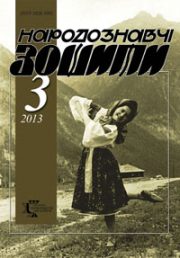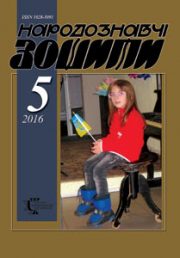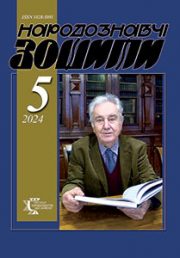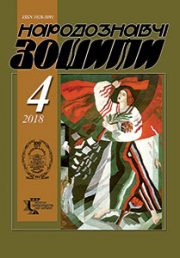The Ethnology Notebooks. 2020. № 5 (155), 1189—1201
UDK 745:7.031.4(477.87)
DOI https://doi.org/10.15407/nz2020.05.1189
FOLK ART OF THE CARPATHIANS THROUGH THE EYES OF SERGE MAKOVSKY (1877—1962)
SELIVATCHOV Michael
- ORCID ID: http://orcid.org/0000-0001-9199-0270
- Doctor of Arts (hab), Professor,
- Professor in the National Academy of Fine Arts and Architcture,
- 20, Voznesensky uzviz, 04053, Kyiv, Ukraine,
- Contacts: e-mail: mik_sel@ukr.net
Abstract. The relevance of the topic: the book by S. Makovsky «Folk Art of Subcarpathian Rus’», published in Russian, Czech (1925) and English (1926) in Prague, influenced the understanding of our traditional creativity to a much lesser extent than it deserves. It was little popularized because of the author’s emigrant past and the proximity to the imperial court. However, the echo of the author’s first aesthetic approach to the folk art can be observed in the texts of some researchers of the 1960ies and later.
The subject and purpose of the article is an analytical coverage of the content and conclusions of this work in the context of Makovsky’ life. This book is a result of exhibition (1924), organized by the school department of the Uzhhorod Civil Administration. As an expert and director of the exhibition, author traveled all over Transcarpathia, observed art objects at the places of their production, talked to artisans, took photos and collected a valuable items. Не consider folk art as not a merely museum memory, but a still living force.
Methods used: biographical, textual, historiographical, comparative.
We conclude that for the first time the folk art of Transcarpathia became the subject of attention not of a museum worker, historian, ethnographer or folk crafts organizer, but of a professional critic who wrote all his life about modern art. In the Carpathians, he encountered creativity, where decorativeness is the main property, inextricably linked with everyday expediency and tradition. Our hero is fascinated by this heritage, greedily perceives it, reflecting on accurate observations and generalizations.
The notes to his essay (pp. 49—52) contain references to fifty editions in Czech, Russian, Ukrainian, German, Hungarian, English, Polish, Romanian, French, Bulgarian. All this testifies an encyclopedic erudition of the author, his careful study of literature on the subject and primary sources. Often he was the first to comprehend something, what will become commonplace and evident after 30 or more years.
Paying tribute to the widespread idea of a folk art decline, Makovsky at the same time emphasizes the ability of a rural creativity for a radical changes in style and poetics under the influence of some talented individuals. In general, folk art for the author is not anonymous. On the contrary, he pays attention to the performers of specific things and names them, identifies the distinctive features, the tools and materials they use, favorite types of products and decorative means.
The descriptions of the analyzed by Makovsky works are rare examples of congenial verbal interpretation by virtue of artistic expressiveness.
Keywords: ethnoaesthetics of Carpathia, ornament, folk craft, household art.
Received 5.10.2020
REFERENCES
- Makovsky, Sergei. (Ed.). (1924). Catalog of the exhibition: «Art and Life of Subcarpathian Rus’», organized under the auspices of the Governor of Subcarpathian Rus’ Antonнn Beskid by the Civil Administration’ School Department of Subcarpathian Rus’in Uzhhorod 1924, March 20 — April 1. Prague: Art and Industrial Museum of Commerce: Trade Chamber [in Сhech].
- Makovsky, Sergei. (Ed.). (1925). Folk art of Subcarpathian Rus’. Prague: Plamya Publishing House [in Russian].
- The Makovsky dynasty. Retrieved from: https://subscribe.ru/group/chelovek-priroda-vselennaya/3468873/ (Last accessed: 25. 10.2020) [in Russian].
- Lebedeva, T.V. (2004). Sergei Makovsky. Pages of life and creativity. Voronezh: Voronezh University Publishing House [in Russian].
- The Makovsky dynasty (continued). Retrieved from: https://subscribe.ru/group/chelovek-priroda-vselennaya/3604553/?utm_source=relap&utm_medium=widget&utm_campaign=link. (Last accessed: 25. 10.2020) [in Russian].
- Lebedeva, T.V. (2006). «Pages of Art Criticism» — the result of the early work of S.K. Makovsky. Voronezh State University Bulletin. Series «Philology. Journalism», 2, 192—198 [in Russian].
- Makovsky, S.K. (1906—1913). Pages of art criticism: in 3 vol. (Volume 1. Thoughts and impressions about the artistic creation of the modern West). St. Petersburg: Sodruzhestvo, 1906; Book 1. Artistic creation of the modern West. 2nd edition with changes and additions. St. Petersburg: Pantheon, 1909; Book 2. Contemporary Russian Artists. St. Petersburg: Pantheon, 1909; Book 3. Exhibitions and characteristics. St. Petersburg: Apollo [in Russian].
- Steinke, Elena. The correspondence between Sergei Makovskij and his sister Elena Luksch-Makovskaja, 1914—1961. Edition, translation and adaptation. Master’s thesis at the Philosophical Faculty of the University of Mьnster 2000. Reviewer: Prof. Frank Kдmper. Eastern Europe Digital Library: History 7. ISSN 1613-1061. Last change on: 11/30/2004. Retrieved from: http://www.vifaost.de (Last accessed: 25. 10.2020) [in German].
- Makovsky, S. (1955). In memory of contemporaries. Articles. New York: Chekhov Publishing House [in Russian].
- Makovsky, S. (1962). On Parnassus of the «Silver Age». Articles. Munich [in Russian].
- Makovsky, S. (1990, 26 september). And I will repay. Novel. Excerpts: Literaturnaya Gazeta [in Russian].
- Makovsky, S. (1922). Silhouettes of Russian artists. Prague: Nasha rech’ [in Russian].
- Makovsky, S.K., Selivachev, M.R., & Savchuk, O.O. (Eds.). (2019). Folk art of the Carpathians. Kharkiv: Publisher Oleksandr Savchuk [in Ukrainian].







